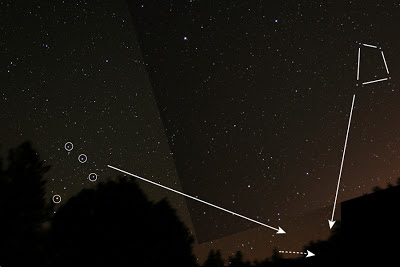Too busy to read my own blog is the best way to describe me in Spring when most of our local schools have their star parties and other astronomy-related events begin (e.g., Explore the Stars).
My astronomy club (TVA) has been sponsoring the astronomy clubs at two middle schools in Murrieta, as well as trying to get these schools to setup their 16-inch telescopes in observatories. The former task is simpler than the later, being done my fellow member Paul Kreitz and me. The second project is driven mainly my our club president Mark Baker, and involves more bureaucracy since new construction is involved.
Each year I try to develop a new show for these schools, and each year I dabble in more complex subjects. This year, however, I got back to basics. Since I didn't have time to develop a new topic, I just refined a few favorites and re-learned that for the most part, middle school students and their families don't need to see intellectual growth from me, but rather, would like a simple subject that they can sink their teeth into. These factors lead me to revisit constellations.
Never underestimate how much people enjoy knowing what constellations are passing overhead, especially if these constellations are well known and include animals and zodiac signs. These most common of constellations are routine to amateur astronomers, but a joy to the general public. Below are some constellations of the Spring sky (in early evening) that I've been sharing at this year's star parties:
Look low, low in the West:
Here's orion and Taurus, which are low in the western horizon and must be viewed just after sunset.
Here is how I see Taurus. I diverge from the standard portrayal of Taurus, which draws impossibly long and U-shaped horns, a feature I find to be cruel.
And here is Orion, the aggressor the hunter. I didn't draw the shield of Orion because I, in my own interpretation, consider the shield area to be in disputed territory between Orion and Taurus.
Ok. Here's the shield, in agreement of standard sky maps that have sided with Orion:
But, everytime I look at Taurus and try to trace the figure, I get this:
The shield, to me, is more convincing as the haunches of Taurus. Though this is how I see Taurus, please note that I've borrowed a piece of Orion, and my interpretation is in conflict with star maps. Use or post on the internet at your own risk.
Here's a wider field of Orion and Taurus taken from backyard. That's my chimney you see.
Taurus:
Orion, the Aggressor:
And Orion's faithful hunting dog (Canis Major), safely guarding the rear, like most family dogs I know would:
Now Look Overhead, slightly to the south.
Another animal shape sits high in the Spring sky and is often considered the centerpiece of spring for its abundance of galaxies.
It's Leo, the Lion:
Leo is most easily found by it's sickle shape, a reverse question mark:
Here are the main brightstars of the lion:
And here is the lion in it's Sphinx-like pose:
I see a lion in profile; official star maps may differ
And Now Look East.
The dominant constellation in the east is the Big Dipper, which is readily recognized by most people.
That was the easy part. But Ursa Major means "Big Bear", so where is the bear?
On a clear night, if you can ignore the stars of the handle and the bowl, the remaining stars make a remarkable bear shape:
But what about the tail? Forget the tail. Some Native American legends refer to the handle stars as hunters chasing the bear. They chase the bear around and around the north pole. It can go on for centuries till someone redraws the constellation.
The dipper does offer a useful metaphor:
In Spring, the dipper is tilted upword as shown in these photos and rotates into an upside-down position. What happens to water in an upside-down dipper? This represents the spring rains that are typical of most of the northern hemisphere (but not the Southwestern United States, where I live):
Those of you enjoying the Midwest's unusual May snowfall can pretend the water drops are snowflakes.
Of course, the big dipper is not complete without it's north star guidance system:
Though Polaris, circled in thie above image, is the north star, it is off of true north by a little bit. I think my circle's center point is a little closer to true north.
Out of fairness, a look at the big dipper should include a look at the little dipper, or Ursa Minor, the Little Bear:
Which really doesn't look much like a bear, or a dipper.
Actually, it looks as much like a bear as any other random area of sky on a dark night.
In the really dark nights, the bright stars of constellations get overwhelmed by the abundance of fainter stars. This can be confusing and liberating. Confusing in that it's a little harder to find the familiar constellations; liberating, in that you have more dots to connect to follow anything you see in your imagination.
jg

































